

POGIL. 5 Tips: Learn more effectively in class with... Instructional Tactics. Encourages higher level thinking (analysis, synthesis and evaluation, for example) Pushes the ability and willingness to consider and integrate opposing perspectives Extends knowledge and clarity around issues Integrates the head and the heart in the learning process De Bono’s Six Thinking Hats (tactic) is useful in the process Necessary Preskills: because this strategy is a complex strategy, a large part of its effectiveness relies on prerequisite skill on the part of both teacher and students.
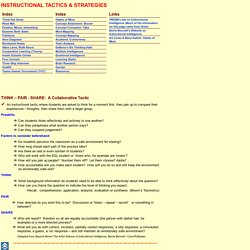
The classroom has been established as a genuinely psychologically ‘safe’ classroom in the eyes of the students. The teacher is attending to David and Johnson’s work, specifically: · Individual accountability · Face to face interaction. The History of Tribes Learning Communities - Tribes Learning Community. Jeanne Gibbs had observed that children’s achievement and behavior in school seemed to be influenced by the quality of the classroom and school environment.
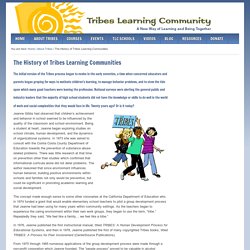
Being a student at heart, Jeanne began exploring studies on school climate, human development, and the dynamics of organizational systems. In 1973 she was asked to consult with the Contra Costa County Department of Education towards the prevention of substance abuse related problems. There was little research at that time on prevention other than studies which confirmed that informational curricula alone did not deter problems. The author reasoned that since environment influences human behavior, building positive environments within schools and families not only would be preventive, but could be significant in promoting academic learning and social development. From 1975 through 1985 numerous applications of the group development process were made through a non-profit corporation which Jeanne founded. References: Gibbs, J. (2001). Conscious competence learning model matrix- unconscious incompetence to unconscious competence. Conscious competence theory - summary outline The conscious competence theory and related matrix model explain the process and stages of learning a new skill (or behaviour, ability, technique, etc.)
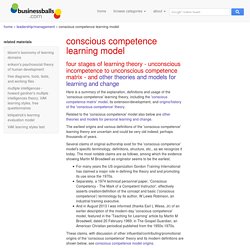
The concept is most commonly known as the 'conscious competence learning model', or 'conscious competence learning theory'; sometimes 'conscious competence ladder' or 'conscious competence matrix'. Other descriptions are used, including terminology relating to 'conscious skilled' and 'conscious unskilled' (which incidentally are preferred by Gordon Training). Occasionally in more recent adapted versions a fifth stage or level is added to the conscious competance theory, although there is no single definitive five-stage model, despite there being plenty of very useful and valid debate about what the fifth stage might be.
K-12 Education Tips & Strategies That Work. Collaborative Learning. Collaborative learning. [1] Collaborative learning is a situation in which two or more people learn or attempt to learn something together.[2] Unlike individual learning, people engaged in collaborative learning capitalize on one another’s resources and skills (asking one another for information, evaluating one another’s ideas, monitoring one another’s work, etc.).[3][4] More specifically, collaborative learning is based on the model that knowledge can be created within a population where members actively interact by sharing experiences and take on asymmetry roles.[5] Put differently, collaborative learning refers to methodologies and environments in which learners engage in a common task where each individual depends on and is accountable to each other.
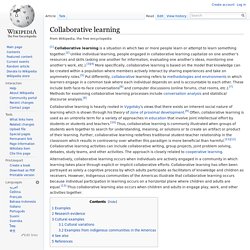
These include both face-to-face conversations[6] and computer discussions (online forums, chat rooms, etc.).[7] Methods for examining collaborative learning processes include conversation analysis and statistical discourse analysis.[8] Examples[edit] 5 Principles For Teaching Adults - GA Blog. The motivations to learn evolve as you become older; and for an adult educator, teaching can be even more difficult without a basic understanding of adult learning theory.
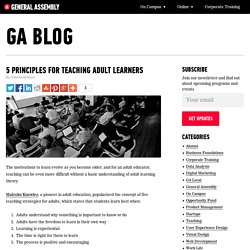
Malcolm Knowles, a pioneer in adult education, popularized the concept of five teaching strategies for adults, which states that students learn best when: Adults understand why something is important to know or doAdults have the freedom to learn in their own wayLearning is experientialThe time is right for them to learnThe process is positive and encouraging This post breaks down each principle outlined above, and details why it’s an important method to teaching adults effectively.
Make sure adults understand why something is important to know or do When we step into adulthood many of us chose to take classes to meet personal and/or careers goals. Adults have the freedom to learn in their own way Visual Learners Visual learners prefer to be shown a lesson through graphs, diagrams, and illustrations. Auditory Learners. View. Learning and Training on Pinterest. Flipping The Classroom.
Teaching Web Design To New Students In Higher Education – Smashing Magazine. Advertisement The Web is evolving rapidly.
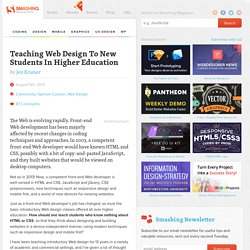
Front-end Web development has been majorly affected by recent changes in coding techniques and approaches. In 2003, a competent front-end Web developer would have known HTML and CSS, possibly with a bit of copy-and-pasted JavaScript, and they built websites that would be viewed on desktop computers. Not so in 2013! Now, a competent front-end Web developer is well-versed in HTML and CSS, JavaScript and jQuery, CSS preprocessors, new techniques such as responsive design and mobile first, and a world of new devices for viewing websites.
Just as a front-end Web developer’s job has changed, so must the basic introductory Web design classes offered all over higher education.